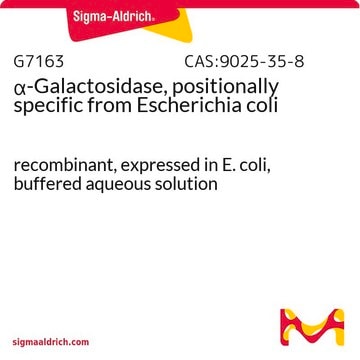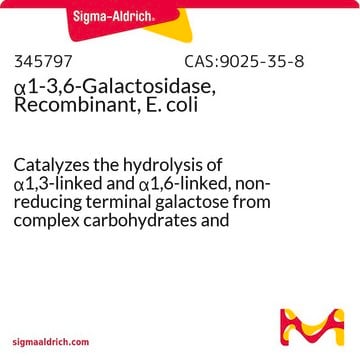G7673
α-Galactosidase I, Alkaline from Cucumis melo
Sinonimo/i:
α-D-Galactoside Galactohydrolase, Melibiase
About This Item
Prodotti consigliati
Ricombinante
expressed in E. coli
Saggio
≥85% (SDS-PAGE)
Stato
lyophilized solid
Attività specifica
≥20 units/mg protein
PM
apparent mol wt ~84 kDa by SDS-PAGE
Condizioni di spedizione
wet ice
Temperatura di conservazione
−20°C
Descrizione generale
Applicazioni
Azioni biochim/fisiol
Proprietà fisiche
Definizione di unità
Stato fisico
Avvertenze
Warning
Indicazioni di pericolo
Consigli di prudenza
Classi di pericolo
Eye Irrit. 2 - Skin Irrit. 2 - STOT SE 3
Organi bersaglio
Respiratory system
Codice della classe di stoccaggio
11 - Combustible Solids
Classe di pericolosità dell'acqua (WGK)
WGK 3
Punto d’infiammabilità (°F)
Not applicable
Punto d’infiammabilità (°C)
Not applicable
Scegli una delle versioni più recenti:
Certificati d'analisi (COA)
Non trovi la versione di tuo interesse?
Se hai bisogno di una versione specifica, puoi cercare il certificato tramite il numero di lotto.
Possiedi già questo prodotto?
I documenti relativi ai prodotti acquistati recentemente sono disponibili nell’Archivio dei documenti.
Filtri attivi
Il team dei nostri ricercatori vanta grande esperienza in tutte le aree della ricerca quali Life Science, scienza dei materiali, sintesi chimica, cromatografia, discipline analitiche, ecc..
Contatta l'Assistenza Tecnica.








